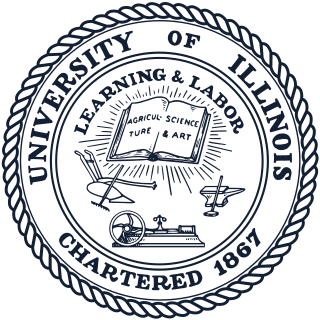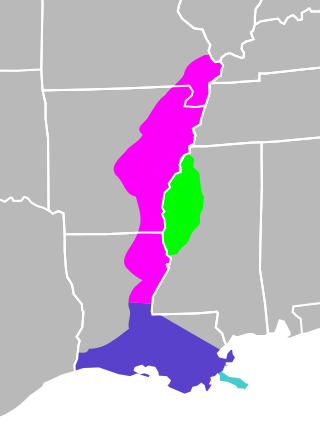Related Research Articles

Abraham Lincoln was the 16th president of the United States, serving from 1861 until his assassination in 1865. He led the United States through the American Civil War, defending the nation as a constitutional union, defeating the Confederacy, playing a major role in the abolition of slavery, expanding the power of the federal government, and modernizing the U.S. economy.

Chicago is the most populous city in the U.S. state of Illinois and in the Midwestern United States. With a population of 2,746,388, as of the 2020 census, it is the third-most populous city in the United States after New York City and Los Angeles. As the seat of Cook County, the second-most populous county in the U.S., Chicago is the center of the Chicago metropolitan area, often colloquially called "Chicagoland" and home to 9.6 million residents.

Illinois is a state in the Midwestern region of the United States. It borders Lake Michigan to its northeast, the Mississippi River to its west, and the Wabash and Ohio rivers to its south. Of the fifty U.S. states, Illinois has the fifth-largest gross domestic product (GDP), the sixth-largest population, and the 25th-most land area. Its capital is Springfield.

The Mississippi River is the primary river of the largest drainage basin in the United States. From its traditional source of Lake Itasca in northern Minnesota, it flows generally south for 2,340 miles (3,766 km) to the Mississippi River Delta in the Gulf of Mexico. With its many tributaries, the Mississippi's watershed drains all or parts of 32 U.S. states and two Canadian provinces between the Rocky and Appalachian mountains. The river either borders or passes through the states of Minnesota, Wisconsin, Iowa, Illinois, Missouri, Kentucky, Tennessee, Arkansas, Mississippi, and Louisiana. The main stem is entirely within the United States; the total drainage basin is 1,151,000 sq mi (2,980,000 km2), of which only about one percent is in Canada. The Mississippi ranks as the thirteenth-largest river by discharge in the world.

Adlai Ewing Stevenson II was an American politician and diplomat and who was the United States Ambassador to the United Nations from 1961 until his death in 1965. He previously served as the 31st governor of Illinois from 1949 to 1953 and was the Democratic nominee for president of the United States in 1952 and 1956, losing both elections to Dwight D. Eisenhower in landslides. Stevenson was the grandson of Adlai Stevenson I, the 23rd vice president of the United States. He was raised in Bloomington, Illinois and was a member of the Democratic Party. He served in many positions in the federal government during the 1930s and 1940s, including the Agricultural Adjustment Administration, Federal Alcohol Administration, Department of the Navy, and the State Department. In 1945, he served on the committee that created the United Nations, and was a member of the initial U.S. delegations to the UN.

Springfield is the capital city of the U.S. state of Illinois and the seat of Sangamon County. The city's population was 114,394 at the 2020 census, which makes it the state's seventh-most populous city, the second-most populous outside of the Chicago metropolitan area, and the most populous in Central Illinois. Approximately 208,000 residents live in the Springfield metropolitan area, which consists of all of Sangamon and Menard counties. Springfield lies in a plain near the Sangamon River north of Lake Springfield. The city is on historic Route 66.

Illinois State University (ISU) is a public research university in Normal, Illinois, United States. It was founded in 1857 as Illinois State Normal University and is the oldest public university in Illinois. The university emphasizes teaching and is recognized as one of the top ten largest producers of teachers in the US according to the American Association of Colleges of Teacher Education. It is classified among "R2: Doctoral Universities – High research activity".

The Chicago metropolitan area, also referred to as the Greater Chicago Area and Chicagoland, is the largest metropolitan statistical area in the U.S. state of Illinois, and the Midwest, containing the City of Chicago along with its surrounding suburbs and satellite cities. Encompassing 10,286 square mi (28,120 km2), the metropolitan area includes the city of Chicago, its suburbs and hinterland, that span 13 counties across northeast Illinois and northwest Indiana. The MSA had a 2020 census population of 9,618,502 and the combined statistical area, which spans 19 counties and additionally extends into southeast Wisconsin, had a population of nearly 10 million people. The Chicago area is the third largest metropolitan area in the United States and the fourth largest metropolitan area in North America, and the largest in the Great Lakes megalopolis. Its urban area is one of the forty largest in the world.

Cahokia Mounds is the site of a pre-Columbian Native American city directly across the Mississippi River from present-day St. Louis. The state archaeology park lies in south-western Illinois between East St. Louis and Collinsville. The park covers 2,200 acres (890 ha), or about 3.5 square miles (9 km2), and contains about 80 manmade mounds, but the ancient city was much larger. At its apex around 1100 CE, the city covered about 6 square miles (16 km2), included about 120 earthworks in a wide range of sizes, shapes, and functions, and had a population of between 15,000 and 20,000 people.

The University of Illinois Urbana-Champaign is a public land-grant research university in the Champaign–Urbana metropolitan area, Illinois, United States. It is the flagship institution of the University of Illinois system and was established in 1867. With over 59,000 students, the University of Illinois is one of the largest public universities by enrollment in the United States.

Northern Illinois University (NIU) is a public research university in DeKalb, Illinois, United States. It was founded as Northern Illinois State Normal School in 1895 by Illinois Governor John P. Altgeld, initially to provide the state with college-educated teachers. In addition to the main campus in DeKalb, it has satellite centers in Chicago, Naperville, Rockford, and Oregon, Illinois.

The Illinois General Assembly is the legislature of the U.S. state of Illinois. It has two chambers, the Illinois House of Representatives and the Illinois Senate. The General Assembly was created by the first state constitution adopted in 1818. As of 2023, the current General Assembly is the 103rd; the term of an assembly lasts two years.

The Illinois House of Representatives is the lower house of the Illinois General Assembly. The body was created by the first Illinois Constitution adopted in 1818. The House under the current constitution as amended in 1980 consists of 118 representatives elected from individual legislative districts for two-year terms with no limits; redistricted every 10 years, based on the 2010 U.S. census each representative represents approximately 108,734 people.

The Illinois Senate is the upper chamber of the Illinois General Assembly, the legislative branch of the government of the State of Illinois in the United States. The body was created by the first state constitution adopted in 1818. Under the Illinois Constitution of 1970, the Illinois Senate is made up of 59 senators elected from individual legislative districts determined by population and redistricted every 10 years; based on the 2020 U.S. census each senator represents approximately 213,347 people. Senators are divided into three groups, each group having a two-year term at a different part of the decade between censuses, with the rest of the decade being taken up by two four-year terms. For example, group one elects senators for terms of four years, four years and two years, group two elects senators for terms of four years, two years and four years, and group three elects senators for terms of two years, four years and four years. This ensures that the Senate reflects changes made when the General Assembly redistricts itself after each census.

The Mississippi River Alluvial Plain is an alluvial plain created by the Mississippi River on which lie parts of seven U.S. states, from southern Louisiana to southern Illinois.
The history of Illinois may be defined by several broad historical periods, namely, the pre-Columbian period, the era of European exploration and colonization, its development as part of the American frontier, its early statehood period, growth in the 19th and 20th centuries, and contemporary Illinois of today.
The University of Illinois Press (UIP) is an American university press and is part of the University of Illinois system. Founded in 1918, the press publishes some 120 new books each year, plus 33 scholarly journals, and several electronic projects. Strengths include ethnic and multicultural studies, Lincoln and Illinois history, and the large and diverse series Music in American Life.

The Supreme Court of Illinois is the state supreme court, the highest court of the judiciary of Illinois. The court's authority is granted in Article VI of the current Illinois Constitution, which provides for seven justices elected from the five appellate judicial districts of the state: three justices from the First District and one from each of the other four districts. Absent mid-term vacancy, each justice is elected for a term of ten years, which may be renewed and the chief justice is elected by the court from its members for a three-year term.

The Illinois Fighting Illini football program represents the University of Illinois Urbana-Champaign in college football at the NCAA Division I Football Bowl Subdivision level. The Fighting Illini are a founding member of the Big Ten Conference. Illinois claims five national championships and 15 Big Ten championships.
References
- ↑ Illinois Blue Book (1965-1966). State of Illinois. 1967. p. 251.